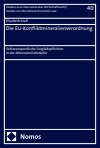Die EU-Konfliktmineralienverordnung
Sektorenspezifische Sorgfaltspflichten in der Mineralienlieferkette
Zusammenfassung
In manchen Teilen der Welt trägt der Abbau sogenannter Konfliktmineralien zur Finanzierung bewaffneter Konflikte bei. Zudem sind Menschenrechtsverletzungen in der Konfliktmineralienlieferkette vielfach dokumentiert. Diesen Missstand adressiert die EU-Konfliktmineralienverordnung aus dem Jahr 2017, die verbindliche Sorgfaltspflichten für die Akteure festlegt, die Konfliktmineralien (Zinn, Wolfram, Tantal, Gold) in die EU einführen. Die Arbeit untersucht, inwieweit Verstöße gegen die Verordnung zu einer zivilrechtlichen Haftung der Importeure führen und welche Rolle die Verordnung im Bereich der Lieferkettenregulierung einnimmt.
Abstract
In some parts of the world, the extraction of conflict minerals contributes to the financing of armed conflicts. In addition, human rights violations occur frequently in the conflict minerals supply chain. This situation is addressed by the EU Conflict Minerals Regulation of 2017, which establishes binding due diligence obligations for actors importing conflict minerals (tin, tungsten, tantalum, gold) into the EU. The monograph examines the extent to which violations of the Regulation lead to civil liability of importers as well as the role of the Regulation in the business and human rights context.
Schlagworte
armed conflict financing Europäische Union EU-Verordnung civil law Finanzierung bewaffneter Konflikte conflict financing Gold conflict minerals conflict minerals regulation Haftung Importeure due diligence Konfliktfinanzierung EU regulation Konfliktmineralien European Union Konfliktmineralienverordnung gold human rights violations Lieferkettenregulierung Menschenrechtsverletzungen importers liability Mineralienlieferkette maladministration Missstand minerals supply chain Sorgfaltspflichten supply chain regulation Tantal tantalum Wolfram Zinn tin tungsten Zivilrecht- Kapitel Ausklappen | EinklappenSeiten
- 27–42 Einleitung 27–42
- 315–339 Literaturverzeichnis 315–339

